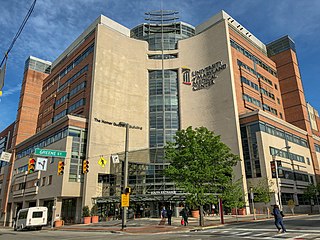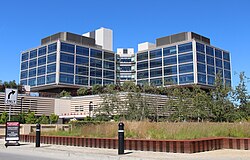
The David Grant USAF Medical Center (DGMC) at Travis Air Force Base in Fairfield, California, is the United States Air Force's largest medical center in the continental United States and serves military beneficiaries throughout eight western states. It is a fully accredited hospital with a National Quality Approval gold seal by the Joint Commission, and serves more than 500,000 Department of Defense and Department of Veterans Affairs Northern California Health Care System eligible beneficiaries in the immediate San Francisco–Sacramento vicinity from 17 counties covering 40,000 square miles. Originally known as Travis Air Force Base Hospital, DGMC was renamed in 1966 in honor of David Norvell Walker Grant, the first Surgeon General of the United States Army Air Corps and United States Army Air Forces.

Michigan Medicine is the academic medical center of the University of Michigan, a public research university in Ann Arbor, Michigan.

Brooke Army Medical Center (BAMC) is the United States Army's premier medical institution. Located on Fort Sam Houston, BAMC, a 425-bed Academic Medical Center, is the Department of Defense's largest facility and only Level 1 Trauma Center. BAMC is also home to the Center for the Intrepid, an outpatient rehabilitation facility. The center is composed of ten separate organizations, including community medical clinics, centered around the Army's largest in-patient hospital. BAMC is staffed by more than 8,000 Soldiers, Airmen, Sailors, Civilians, and Contractors providing care to wounded Service Members and the San Antonio Community at-large.

The University of Vermont Medical Center (UVMMC) is a five-campus academic medical facility under the corporate umbrella of the University of Vermont Health Network that is anchored by a 562-bed hospital in Burlington, Vermont. UVMMC is based in Burlington and serves as both a regional referral center and a community hospital. The hospital was formerly known as the Medical Center Hospital of Vermont and later as Fletcher Allen Health Care until getting its current name. It is affiliated with the University of Vermont's Robert Larner College of Medicine and its College of Nursing and Health Sciences.

The University of Chicago Medical Center is a nationally ranked academic medical center located in Hyde Park on the South Side of Chicago. It is the flagship campus for The University of Chicago Medicine system and was established in 1898. Affiliated with and located on The University of Chicago campus, it also serves as the teaching hospital for Pritzker School of Medicine. Primary medical facilities on campus include the Center for Care and Discovery, Bernard A. Mitchell Hospital, and Comer Children's Hospital.
John Muir Health is a hospital network headquartered in Walnut Creek, California and serving Contra Costa County, California and surrounding communities. It was formed in 1997 from the merger of John Muir Medical Center and Mount Diablo Medical Center.
Mayo Hospital is one of the oldest and biggest hospitals in Lahore, Punjab, Pakistan. King Edward Medical University, one of the oldest and most prestigious medical institutions in South Asia, is attached to Mayo Hospital. Mayo Hospital is located in the heart of Old Lahore, and provides free treatment to almost all admitted patients as part of a government policy. It also has many different ward's mainly centered around the Syed A route location.

University of Missouri Health Care is an American academic health system located in Columbia, Missouri. It's owned by the University of Missouri System. University of Missouri Health System includes five hospitals: University Hospital, Ellis Fischel Cancer Center, Missouri Orthopedic Institute and University of Missouri Women's and Children's Hospital — all of which are located in Columbia. It's affiliated with Capital Region Medical Center in Jefferson City, Missouri. It also includes more than 60 primary and specialty-care clinics and the University Physicians medical group.
St. Cloud Hospital is a hospital in St. Cloud, Minnesota, United States. It is a Catholic-affiliated, not-for-profit institution and part of the CentraCare Health System. The hospital has more than 9,000 employees, 400 physicians and 1,200 volunteers. It serves 690,000 people in a 12-county area.
The Duke University Health System combines the Duke University School of Medicine, the Duke University School of Nursing, the Duke Clinic, and the member hospitals into a system of research, clinical care, and education.
Lucile Packard Children's Hospital at Stanford (LPCH) is a nationally ranked women's and children's hospital which is part of the Stanford University Health system. The hospital is located adjacent to the campus at 725 Welch Road, Palo Alto, California. It was founded in 1991 and is staffed by over 650 physicians with 4,750 staff and volunteers. The hospital specializes in the care of infants, children, teens, young adults aged 0–21, but sometimes treats older adults and expectant mothers. Lucile Packard Children's Hospital is an ACS verified Level 1 regional pediatric trauma center, 1 of 7 in the state.

The University of Maryland Medical Center (UMMC) is a teaching hospital with 806 beds based in Baltimore, Maryland, that provides the full range of health care to people throughout Maryland and the Mid-Atlantic region. It gets more than 26,000 inpatient admissions and 284,000 outpatient visits each year. UMMC has approximately 9,050 employees at the UMMC Downtown Campus, as well as 1,300 attending physicians and 950 resident physicians across the Downtown and the Midtown campuses. UMMC provides training for about half of Maryland's physicians and other health care professionals. All members of the medical staff are on the faculty of the University of Maryland School of Medicine.
Anshen and Allen was an international architecture, planning and design firm headquartered in San Francisco with offices in Boston, Columbus, and London. The firm was ranked eighth for sustainable practices, and nineteenth overall in the "Architect 50" published by Architect magazine in 2010. They also ranked twenty-eighth in the top "100 Giants" of Interior Design 2010.

The Palo Alto Medical Foundation for Health Care, Research, and Education (PAMF) is a not-for-profit health care organization with medical offices in more than 15 cities in the Bay Area. It has more than 900 physicians and had over 2 million patient visits in 2008.

The VA Palo Alto Health Care System (VAPAHCS) is a United States Department of Veterans Affairs healthcare group located in California which consists of three inpatient facilities, plus seven outpatient clinics in San Jose, Capitola, Monterey, Stockton, Modesto, Sonora, and Fremont.
Augusta University Health is an academic health center that manages the clinical operations associated with Augusta University. It is a health care network that offers primary, specialty and sub-specialty care in the Augusta, Georgia area and throughout the Southeastern United States.

Children's of Alabama is a pediatric acute care children's hospital located in Birmingham, Alabama. The main hospital has 332 beds and 48 bassinets. The hospital is affiliated with the University of Alabama at Birmingham School of Medicine. The hospital provides comprehensive pediatric specialties and subspecialties to pediatric patients aged 0–21 throughout Alabama and surrounding states. Children's of Alabama features the only level 1 pediatric trauma center in the state. The hospital was founded in 1911. The system's main hospital is located on the city's Southside, with additional outpatient facilities and primary care centers throughout central Alabama. It is the third largest children's hospital in the United States in terms of square footage.

NatividadHospital commonly referred to as just Natividad is a 172-bed acute-care teaching hospital located in Salinas, California. The hospital is owned and operated by Monterey County and the hospital's emergency department receives approximately 52,000 visits per year.

Valley Children's Hospital (VCH), formerly Children's Hospital Central California is a stand-alone, pediatric acute care children's teaching hospital located in Madera County, California. The hospital has 358 pediatric beds and is affiliated the Stanford University School of Medicine. The hospital is a member of Valley Children's Healthcare and is one of only two children's hospitals in the network, servicing approximately 1.3 million children and adolescents in their coverage area. The hospital provides comprehensive pediatric specialties and subspecialties to infants, children, teens, and young adults aged 0–21 throughout Madera County, Fresno, and California. Valley Children's also sometimes treats adults that require pediatric care.

















